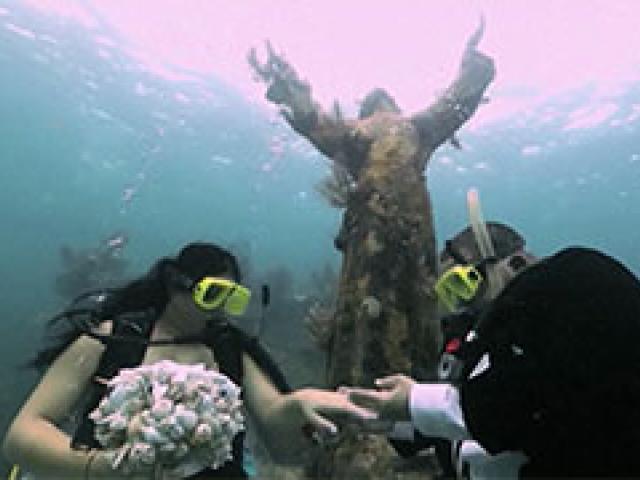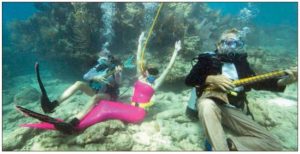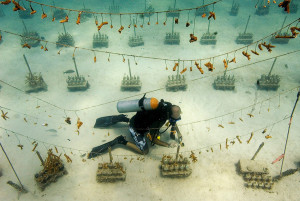Visitors to the Florida Keys Reefs can snorkel or dive on the continental United States’ only contiguous living coral barrier reef — which makes the destination a paradise for underwater enthusiasts. Also the third-largest barrier reef in the world, the Keys tract is home to stunning coral formations and brilliantly hued tropical fish.
Much like a tropical rainforest, this reef ecosystem supports an incredibly diverse population of plants and animals that can be observed by divers and snorkelers.
 The coastal waters of the entire island chain are protected within the Florida Keys National Marine Sanctuary. Dive and snorkel operators from Key Largo to Key West offer excursions led by experts who are passionate about the underwater realm.
The coastal waters of the entire island chain are protected within the Florida Keys National Marine Sanctuary. Dive and snorkel operators from Key Largo to Key West offer excursions led by experts who are passionate about the underwater realm.
The Florida Keys’ clear, warm waters even attract scuba aficionados ready to tie the knot at the living coral reef with exotic sea creatures in attendance. The wedding party and guests can don gowns, tuxedos, boutonnières and bathing suits for a uniquely marine matrimony.
 A famous Upper Keys underwater nuptial niche is the 9-foot-high shrine of “Christ of the Abyss,” a 4,000-pound bronze statue within the Florida Keys National Marine Sanctuary, in waters adjacent to Key Largo’s John Pennekamp Coral Reef State Park. The statue is one of the most photographed underwater sites in the world, and its welcoming arms make a perfect place to exchange “I do’s.”
A famous Upper Keys underwater nuptial niche is the 9-foot-high shrine of “Christ of the Abyss,” a 4,000-pound bronze statue within the Florida Keys National Marine Sanctuary, in waters adjacent to Key Largo’s John Pennekamp Coral Reef State Park. The statue is one of the most photographed underwater sites in the world, and its welcoming arms make a perfect place to exchange “I do’s.”
Divers and snorkelers can explore a portion of the iconic Keys reef while rocking to a sub-sea concert during the annual Florida Keys Reefs Lower Keys Underwater Music Festival.

Staged the first Saturday after the July 4 holiday, the quirky songfest takes place at Looe Key Reef, an area of the Florida Keys National Marine Sanctuary approximately 6 miles south of Big Pine Key. Music is broadcast underwater via Lubell Laboratory speakers suspended beneath boats positioned above the reef.
Participants might even spot whimsically costumed divers or “mermaids” tooting their own horns on the ocean floor — pretending to play underwater musical instruments like a trom-bonefish and clambourine sculpted by Florida Keys artist August Powers.
As well as offering unique enjoyment for dive enthusiasts, the festival carries a serious message of reef preservation. The broadcast incorporates diver awareness announcements emphasizing ways to enjoy the reef while minimizing impacts on the underwater environment.
Dive voluntourism is growing, and certified divers can join hands-on dive activities in underwater coral nurseries, outplanting corals to FlKeys reefs, or monitoring the wellness of corals in existing coral colonies.
 Mote Marine Tropical Research Laboratory, the Summerland Key–based field station of Sarasota-based Mote Marine Laboratory, and Key Largo’s Coral Restoration Foundation each invite “citizen scientists” to assist with the endeavor.
Mote Marine Tropical Research Laboratory, the Summerland Key–based field station of Sarasota-based Mote Marine Laboratory, and Key Largo’s Coral Restoration Foundation each invite “citizen scientists” to assist with the endeavor.
Divers and snorkelers play a significant role as stewards of the world’s oceans and through such opportunities can productively give back to the living, dynamic ecosystem they enjoy seeing.
Two unique underwater programs spotlight the Florida Keys reefs and shipwrecks for enthusiasts, and each offers specially created souvenir journals for participants.
The official Florida Keys Wreck Trek logbook lists nine of the island chain’s most iconic wreck sites: Duane, Benwood, Eagle, Thunderbolt, Adolphus Busch Senior, Cayman Salvager, Joe’s Tug, and two of the world’s largest shipwrecks intentionally sunk as artificial reefs: Spiegel Grove and Gen. Hoyt S. Vandenberg.
Advanced or wreck-certified divers who complete at least one wreck dive with a participating dive operator receive the logbook and a personalized print of Florida Keys shipwrecks.
First-timers, families and fun-loving outdoor groups can join the Become a Reef Explorer program. Participants collect validation stamps from professional dive or snorkel operators, indicating they have visited one or all of the coral reefs highlighted in the journal.
